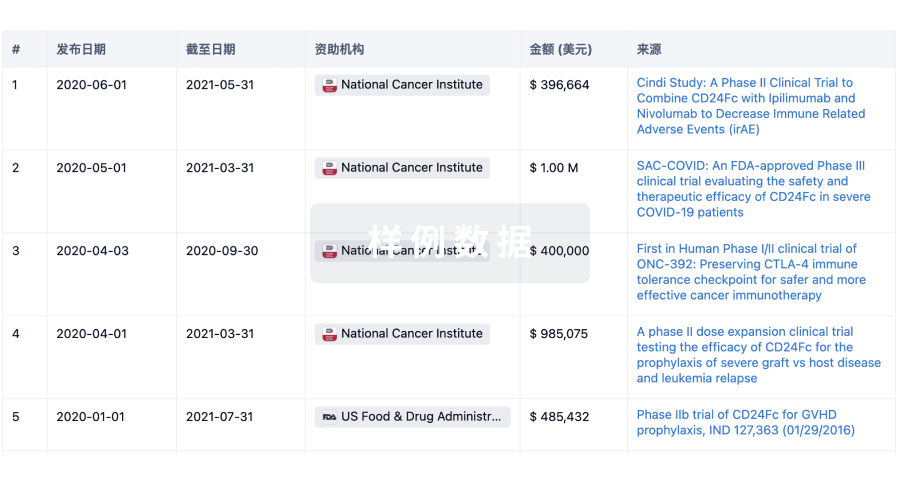预约演示
更新于:2025-05-07

Nanjing Children's Hospital Ltd.
更新于:2025-05-07
概览
标签
通用型CAR-T
疾病领域得分
一眼洞穿机构专注的疾病领域
暂无数据
技术平台
公司药物应用最多的技术
暂无数据
靶点
公司最常开发的靶点
暂无数据
| 排名前五的药物类型 | 数量 |
|---|---|
| 通用型CAR-T | 1 |
关联
1
项与 南京市儿童医院 相关的药物55
项与 南京市儿童医院 相关的临床试验ChiCTR2400093391
A Randomized Controlled Trial of Thyroid Hormone Replacement Therapy in Children with Euthyroid Sick Syndrome Following Congenital Heart Disease Surgery with Cardiopulmonary Bypass
开始日期2025-01-01 |
申办/合作机构 |
NCT06751134
A Study to Evaluate the Safety, Preliminary Efficacy, Pharmacokinetics of CNK-UT Cells to Treat the Patients with Relapsed/refractory Neuroblastoma
This is a single arm, open-label, multi-center, pilot studies (Investigator Initiated Trial, IIT) to evaluate the safety, preliminary efficacy, pharmacokinetics of universal T-cells engineered with chimeric natural killer receptor (CNK-UT) to treat the patients with relapsed/refractory Neuroblastoma.
开始日期2024-12-28 |
申办/合作机构 |
ChiCTR2400089888
Mechanism and efficacy prediction indicators Following Repetitive Transcranial Magnetic Stimulation in Children With ASD:Functional magnetic resonance imaging study
开始日期2024-09-22 |
申办/合作机构 |
100 项与 南京市儿童医院 相关的临床结果
登录后查看更多信息
0 项与 南京市儿童医院 相关的专利(医药)
登录后查看更多信息
353
项与 南京市儿童医院 相关的文献(医药)2025-12-31·Human Vaccines & Immunotherapeutics
Surveillance on the coverage of herpes zoster vaccine and post-marketing adverse events in Jiangsu province, China
Article
作者: Sun, Xiang ; Zhang, Lei ; Sun, Jinning ; Wang, Zhiguo ; Zhang, Tingting ; Liu, Li ; Sun, Hui ; Xu, Yan ; Liu, Yuan Bao ; Fu, YaLi ; Hu, Ran
2025-12-31·Renal Failure
Xuebijing injection alleviates septic acute kidney injury by modulating inflammation, mitochondrial dysfunction, and endoplasmic reticulum stress
Article
作者: Zhang, Lei ; Jiang, Guiya ; Zhang, Guangyuan ; Gao, Yue ; Chen, Shuqiu ; Mao, Weipu ; Lu, Xun ; Chen, Ming ; Sun, Si ; Tao, Shuchun ; Zhang, Nieke
2025-12-01·Journal of Clinical Immunology
X-linked Deficiency in ELF4 in Females with Skewed X Chromosome Inactivation
Article
作者: An, Yunfei ; Zhang, Zhuo ; Mei, Shiyue ; Zhou, Fang ; Zhao, Xiaodong ; Zhang, Qianlu ; Zhao, Rongtao ; Liu, Zhifeng ; Du, Hongqiang ; Zhou, Lina ; Tang, Xuemei ; Sun, Li ; Lv, Qianying ; Sun, Gan
4
项与 南京市儿童医院 相关的新闻(医药)2024-12-09
·医药地理
抗GD2单抗那西妥单抗治疗神经母细胞瘤临床应用专家共识(2024年版)
神经母细胞瘤免疫治疗临床应用协作组
引用
神经母细胞瘤免疫治疗临床应用协作组. 抗GD2单抗那西妥单抗治疗神经母细胞瘤临床应用专家共识(2024年版)[J]. 世界临床药物, 2024, 45(11): 1105-1115.
DOI:10.13683/j.wph.2024.11.001.
专家简介
执笔专家 :董岿然(复旦大学附属儿科医院)。
协作组专家名单(按姓名汉语拼音排序):蔡炜嵩(中国医科大学附属盛京医院)、陈伟明(复旦大学附属儿科医院)、董岿然(复旦大学附属儿科医院)、段栩飞(华中科技大学同济医学院附属武汉儿童医院)、方拥军(南京医科大学附属儿童医院)、高举(四川大学华西第二医院)、高群(安徽省儿童医院)、贺湘玲(湖南省人民医院)、黄东生(首都医科大学附属北京同仁医院)、蒋莎义(上海市儿童医院)、黎阳(中山大学孙逸仙纪念医院)、李涛(南京市儿童医院)、李勇(湖南省儿童医院)、刘洪军(安徽省儿童医院)、刘秋玲(中国人民解放军总医院)、刘嵘(首都儿科研究所)、茅君卿(浙江大学医学院附
属儿童医院)、钱晓文(复旦大学附属儿科医院)、邵静波(上海市儿童医院)、苏雁(首都医科大学附
属北京儿童医院)、王焕民(首都医科大学附属北京儿童医院)、王金湖(浙江大学医学院附属儿童医院)、王景福(山东省肿瘤医院)、王珊(重庆医科大学附属儿童医院)、吴晔明(上海交通大学医学院附属新华医院)、徐敏(上海交通大学医学院附属上海儿童医学中心)、袁晓军(上海交通大学医学院附属新华医院)、翟晓文(复旦大学附属儿科医院)、张守华(江西省儿童医院)、张伟令(首都医科大学附属北京同仁医院)、张翼鷟(中山大学肿瘤防治中心)、赵强(天津医科大学肿瘤医院)、庄培钧(复旦大学附属儿科医院)。
背景介绍
神经母细胞瘤 (neuroblastoma,NB) 是儿童期最常见的颅外实体肿瘤,其生物学行为多样,预后差异显著。相较低、中危 NB 患儿,高危 (highrisk,HR)-NB 患儿占比高且预后差。我国一项纳入 1041 例 NB 患儿的单中心研究显示,HR-NB 患儿占比超 50%,5 年总生存率 (overall survival,OS) 为 48.9%,5 年无事件生存率仅 37.7% 。
神经节苷脂 (ganglioside,GD)2 是一种含唾液酸的鞘糖脂,几乎所有 NB 细胞都表达 GD2 抗原。那西妥单抗能与 GD2 结合,并通过抗体依赖细胞介导的细胞毒作用 (antibody-dependent cellmediated cytotoxicity,ADCC)、补体依赖的细胞毒作用(complement-dependent cytotoxicity,CDC) 及抗体依赖的细胞吞噬作用机制,使肿瘤细胞裂解和死亡。
章节导览
1 HR-NB 治疗现状
2 抗 GD2 单克隆抗体免疫治疗
2.1 抗 GD2 单克隆抗体概述
2.2 那西妥单抗基本信息
3 那西妥单抗用药前评估及用药方案
3.1 用药前评估
3.2 用药方案
4 那西妥单抗用药前评估及用药方案
4.1 安全性特征
4.2 输注前用药
4.3 输注期间监护及不良反应处理
5 疗效评估及随访策略
6 结语
主要内容
那西妥单抗于2020年11月通过美国FDA的快速审批,用于治疗难治/复发性NB,于2022年11月被批准在中国上市。《共识》指出,那西妥单抗作为目前获批的人源化抗GD2单抗,具有抗药抗体发生率低,周期给药剂量更高,输注时间较短(30-60 分钟),国外在门诊即可完成给药等特点。
《共识》推荐了那西妥单抗的三种用药方案——
方案1:那西妥单抗+粒细胞-巨噬细胞集落刺激因子GM-CSF
在一项全球多中心、单臂、开放标签的Ⅱ期研究201研究中,纳入伴有骨和/或骨髓病灶且对既往治疗未达到完全缓解(CR)的难治/复发(R/R)HR-NB患者共计52例,那西妥单抗联合GM-CSF治疗的客观缓解率(ORR)为50%,其中CR率为38%。达到首次CR或部分缓解(PR)的中位时间(治疗周期)为6.7周(约2个周期)。中位无进展生存期(PFS)为30周,1年PFS为35%,1年OS为93%。
方案2:那西妥单抗+GM-CSF+伊立替康+替莫唑胺(HITS)治疗
对标准诱导治疗后难治性NB患者积极采用HITS方案作为“桥接治疗”,相较在多种其他治疗之后再采取HITS治疗能获得更好的远期预后。
方案3:那西妥单抗+GM-CSF+异维甲酸13-cis-RA
抗GD2单抗已被推荐用于高危神经母细胞瘤维持治疗的标准治疗。那西妥单抗+GM-CSF单用或联合异维甲酸用于CR的HR-NB患者的维持治疗可帮助改善远期预后。
小结
《共识》指出,通过海南先行先试区和上市后我国各地医疗中心用药积累的数据显示,在用药预案、人员培训以及给药、监护、急救等设备充分准备情况下,可以实现那西妥单抗用药安全可控,其短期输注方案亦为治疗带来便利,并在一定程度上改善患者与家庭的生活质量。《共识》推荐用药方案基于临床研究、真实世界研究以及国内外专家临床实践经验总结而成,具体用药需要根据患儿临床情况进行个体化实施。
↑长按二维码阅读原文
聚焦药物综合评价 促进临床合理用药
请看《世界临床药物》!
本刊为月刊,大16开。邮发代号4-302,全国各地邮局均可订阅。
定价:26元,全年312元。
订阅电话:021-62790477-751
订阅传真:021-62473200
订阅邮箱:guohx@pharmadl.com
END
如需获取更多数据洞察信息或公众号内容合作,请联系医药地理小助手微信号:pharmadl001
临床研究
2023-06-11
关注并星标CPHI制药在线 在上一篇文章中,我们介绍了2025版中国药典中药变化预测和生物制品变化预测(《 兔年谈之六:2025版中国药典渐显真容之(一)》)。在这篇文章中,我们会重点预测2025版药典涉及化学药品、辅料和包材的变化情况。 第一部分:2025版药典大纲要点-化药部分 根据中国药典2025版编制大纲要求,关键内容如下: 1- 新增品种约100个,继续扩大临床常用药品的收载。 2- 充分利用仿制药质量与疗效一致性评价及国家药品抽检成果推进国家标准修订,加强成果向国家标准转化。 3- 修订完善适应新形势新要求的化学药品国家标准制修订程序和技术规范(国家药品标准工作手册)。 4- 建设准确的比较完整的化学药品国家标准数据库。 第二部分:2025版药典化药标准变化预测 变化1-部分制剂通则会被修订 根据目前掌握的中国药典委官网信息,片剂、散剂和糖浆剂的制剂通则肯定会被修订,草案已经发布供行业反馈意见。考虑到吸入制剂的快速发展,估计这个关键制剂通则也会被修订。 变化2-杂质相关指导原则会被修订 大纲提到:完善有关物质检查指导原则。依据风险管理原则,继续加强对各类杂质控制的研究,把影响药品安全性的主要杂质的有关信息列入标准中。鉴于过去5年ICH涉及有关物质、元素杂质和残留溶媒的指南都有变化,应该会修订这些指导原则;而且对中国已上市药品开始逐步强制实施ICH Q3C和ICH Q3D。另外,2025版药典会继续加强对β-内酰胺类抗生素聚合物和有关物质检查方法的优化研究,合理设置限度。 变化3-制订窄治疗窗药物国家标准制修订工作细则。 目前这类药物的研发、监管和临床安全应用都存在一定管理空白。例如2023年5月有媒体报道:南京市儿童医院给一个婴儿输注氨 茶 碱后,监护不利,导致婴儿死亡,目前事情还处于调查和调节阶段。 变化4-增加静脉输液及滴眼液等的渗透压控制措施。 对于这些特殊品种的渗透压监管,目前中国药典2020版还规定很少;2025版药典亟待增加相关内容。 变化5-遗传毒 性杂质的预警和监测会被加强 预测中国药典2025版会根据ICH M7的修订进展,对这个问题出台专门的指导原则。CDE已经发布了针对亚硝胺的指导原则,药典委的指导原则应该在更高站位和更全面方面提升指导原则的质量。 变化6-对溶出度和释放度检查法进行修订完善,提升对现有常释口服固体制剂(如降糖药等)和缓控释制剂有效性项目的控制水平 随着一致性评价工作的深入和全面开展,中国制药行业对于类似问题已经有较深刻认识,因此相关指导原则会被修订和完善。 变化7-起草抗酸药制酸力试验的指导原则,并修订吸入制剂、透皮贴剂、脂质体注射剂的配套指导原则 这些针对特殊制剂的工作目前还是空白,估计2025版药典会增加相关内容。 变化8-药品鉴别技术会提高,新的《药品红外光谱集》会发布 根据行业调研情况,拟把HPLC/UV(DAD或PDA)(高效液相色谱-二极管阵列紫外检测器)用于鉴别。继续加强对多晶型品种的研究,必要时建立适宜的检测方法;很可能出版《药品红外光谱集》(合订本)。 变化9-放射性药品活性控制方法会被重视 近几年,国家药监局多次发文,强化对放 射 性药品的监管。药典2025版会配合行动,积极推进相关控制方法的质控手段。 变化10-强化分析技术的知识管理 大纲提到:关注色谱填料对于不同结构与极性的药品与杂质分离的适用性,对液相色谱柱填料进行科学分类,编制HPLC系统适用性图谱集,建立色谱图集数据库,在药典会外网设立应用专栏,为药品标准的执行提供支持。 变化11-化药命名管理会被持续强化 2025版药典会持续完善化学药品通用名称命名原则;拟定建立可供便捷查询的化学药品通用名称数据库。 第三部分:2025版药典大纲要点-辅料部分和技术通则部分 根据中国药典2025版编制大纲要求,关键内容如下: 1- 增修订通用技术要求80个。 2- 进一步梳理并增修订已收载制剂和剂型及其各类亚剂型的分类、定义。 3- 梳理并增修订制剂通则各制剂与剂型一般性技术要求,重点关注先进技术、方法和要求的收载。 4- 有序稳步推进《中国药典》中制剂通则相关检测内容与ICH指导原则的协调工作。 5- 积极跟踪并开展药用辅料关键质控技术及标准制定方法的研究,及时进行转化并稳步实施。 6- 加强与国际、国内相关标准的协调,药辅同源品种标准的协调,同品种多规格和同系列品种标准的规范与协调。 7- 深化社会共制共享机制,鼓励药品及药用辅料生产、使用、检验、科研等各类机构积极参与药用辅料标准制定。 8- 进一步完善以检验机构为主的药用辅料标准"监护人"制度 第四部分:2025版药典辅料部分和技术通则的变化预测 变化1-常用关键分析方法指导原则会被修订 制药行业常用分析技术,例如液相色谱法、气相色谱法、质谱法、核磁共振波谱法、X射线荧光光谱法、原子荧光光度法、扫描电子显微镜法的指导原则会被修订;而且会掌握分寸,对于国产分析仪器进行适当保护。 变化2-目前药典缺失的一些分析项目指导原则会被制订和修订 根据大纲要求,会修订:粒度和粒度分布测定法动态光散射法和光阻法、抗酸药制酸力测定法、固有溶出测定法、流变学测定法等。另外,为了保护环境和操作人员安全,会修订溶液颜色检查法、澄清度检查法、试剂标准等。 变化3-ICH Q4的工作要求会被2025版药典体现 自从2017年6月19日,中国国家药监局加入ICH以来,在很多领域和ICH加强了合作,也产生了很大变化。但是药典协调这项工作迟迟没有进展。虽然目前从官网看动作不大,但是可以预测2025版药典对相关技术工作进展,会有体现。 变化4-微生物控制技术指导原则会被修订 2025版药典大纲提到:加强特殊制剂的个性化微生物检测方法的研究,开展生物负载、生产环境污染监控、无菌产品包装密闭性以及微生物杀灭技术等相关方法的增修订等。但是必须要提到的,2020版药典灭菌法部分完全照搬USP内容,部分荒唐描述让行业觉得不可思议。 变化5-新制订非无菌药品中不可接受微生物项目 虽然中国药典过去针对致病菌有例行控制要求,但是针对行业最新认识的一些不可接受微生物,目前控制措施还是空缺的。因此,2025版药典肯定会包含这些新内容,例如BCC。此外,涉及中药饮片的一些微生物控制项目,也要被调整。 变化6-PAT分析技术会被重视 为了促进QBD理念的贯彻,以及配合ICH Q13连续制造的推广,2025版药典会收载多项涉及PAT的分析技术,例如多变量统计过程控制技术、化学成像技术、化学计量学、近红外分光光度法等的指导原则。 变化7-理化分析的基础部分会加强 世界各国药典对于天平管理和规范称量都有要求,而中国药典一直处于缺失状态。2025版药典会弥补这些不足。 变化8-药学技术相关指导原则会被收载 涉及数值修约、药学计算、边界值取舍、不确定度评估等内容,2025版药典应该会有突破。 变化9-现代化微生物控制理念会被强化 根据行业发展态势,估计如下技术指导原则会被收载:微生物快速检测方法、微生物检验替代方法验证指导原则、药品无菌保障技术指导原则、灭菌工艺选择决策树等指导原则。 变化10-药用辅料红外核磁等配套图谱发布 为了促进辅料规范管理,为MAH规范管理辅料提供技术支持,可能会出台辅料的红外核磁图谱等书籍。 变化11-辅料标准监护人制度会更加完善 为了让辅料标准制定规范,具有实用性,药典委推出了辅料标准监护人制度。这个制度已经多次修订,对于加强辅料标准实用性建设,具有积极意义。 变化12-制药用水标准会有明显变化 这项工作在2020版药典修订时,已经完成部分基础工作。这次随着2025版药典,会有明显变化。 第五部分:2025版药典大纲要点-包材部分 根据中国药典2025版编制大纲要求,关键内容如下: 1- 梳理、跟进国内外药包材及相关领域的标准体系及发展趋势,充分借鉴吸纳先进理念及优势技术;构建适宜我国行业发展和监管需要的《中国药典》药包材标准体系 2- 制定药包材基础标准和规范,如术语、命名原则、标准体例规范等。 3- 制定药包材通则,内容包含药包材分类、生产、质量评价、使用、包装、储运、安全性、相容性、保护性、功能性、稳定性等总体要求。 4- 制定不同材质药包材通则(如玻璃、橡胶、塑料、金属、陶瓷等)和具体品类通则(如玻璃安瓿、橡胶密封件、塑料硬片、铝盖等),覆盖常用药包材的检测项目、技术要求等。 5- 制定特殊包装系统的通则,如预充式包装系统(包含预灌封注射器和笔式注射器等)。 6- 制定药包材指导原则,如密封完整性、生物学安全性、塑料和橡胶的稳定性等评价指导原则。 第六部分:2025版药典包材变化预测 根据中国药典2025版编制大纲要求,关键内容如下: 变化1-包材命名和分类指导原则会更健全 大纲提到:制定药包材基础标准和规范,如术语、命名原则、标准体例规范等。另外,会制定药包材通则,内容包含药包材分类、生产、质量评价、使用、包装、储运、安全性、相容性、保护性、功能性、稳定性等总体要求。 变化2-建立不同材质的技术通则 例如针对玻璃、橡胶、塑料、金属、陶瓷等会建议分类针对性指导原则,并针对玻璃安瓿、橡胶密封件、塑料硬片、铝盖这些不同类型包材,建议配套指导原则。 变化3-针对特殊包装系统会继续完善指导原则 例如针对预充式包装系统(包含预灌封注射器和笔式注射器等)、吸入制剂包装系统、一次成型包装系统(如吹灌封包装系统BFS、自动成型灌封袋FFS等)、热塑性弹性密封体、环烯烃共聚物等;分别建立配套指导原则。 变化4-针对包材基础项目进行规范 例如会针对密封完整性、生物学安全性、塑料和橡胶的稳定性等项目,建立指导原则。 总结 现在已经到2023年中期,虽然从药典委官网看,公开发布的2025版药典修订工作内容还是局部;但是从总体工作量看,要完成如此庞大的修订任务量,估计2023年下半年很多技术工作的成果会明显展示出来。MAA在药品研发过程中,要密切注意药典的修订进展,以便调整项目研发进度和方向。 系列文章《兔年谈之一:欧盟关键法规和指南检索应用》《兔年谈之二:FDA指南更新计划释放行业监管新信号》《兔年谈之三:中药研发之激战2023》《兔年谈之四:中国药品标准体系的演变点滴》《兔年谈之五:燕京来文惊初夏,深夜香茗感雪风 ---也谈<20230524关于加强委托生产药品上市许可持有人监管工作的通知征求意见稿>》《兔年谈之六:2025版中国药典渐显真容之(一)》 作者简介zhulikou431,高级工程师、PDA会员、ISPE会员、ECA会员、PQRI会员、资深无菌GMP专家,在无菌工艺开发和验证、药品研发和注册、CTD文件撰写和审核、法规审计、国际认证、国际注册、质量体系建设与维护领域,以及无菌检验、环境监控等领域皆具有较深造诣。近几年开始着力关注制药宏观领域趋势分析和制药企业并购项目的风险管理工作。【企业推荐】智药研习社近期课程报名来源:CPHI制药在线声明:本文仅代表作者观点,并不代表制药在线立场。本网站内容仅出于传递更多信息之目的。如需转载,请务必注明文章来源和作者。投稿邮箱:Kelly.Xiao@imsinoexpo.com▼更多制药资讯,请关注CPHI制药在线▼点击阅读原文,进入智药研习社~
一致性评价生物类似药医药出海
2023-03-21
·动脉网
咬定青山不放松,立根原在破岩中。千磨万击还坚劲,任尔东西南北风。——清·郑燮《竹石》清代诗人郑燮一定想不到,自己所咏的《竹石》,会在百余年后,被一位来自南京的80后工科小伙,以科技为笔,在医学教育这张庄严而广袤的图纸上,描绘出壮丽景色。“我很喜欢这首诗,特别是‘扎根’和‘向上’之意。我希望我们公司能扎根行业力争上游,以科技之极助力医教行业创新。也希望公司发展能像竹子一样节节高。”竹石科技创始人周坚带着腼腆的笑意向动脉网介绍道。2023年3月12日,这家专业从事医学数字化教学产品以及医学虚拟仿真教学产业研究开发的高新技术企业迎来了自己四岁的生日。竹石信息集产业研究、产品开发及行业应用于一体,致力于新技术在医学教育领域的实践与应用,是国内为数不多的具有医学教育全套信息化、数字化系统产品线的制造商。公司主要技术包括云计算技术、大数据分析技术、VR虚拟现实技术、AR增强现实技术、MR混合现实技术、XR扩展现实技术、融合投影技术、人体姿态识别技术、语音识别技术、生物信息分析技术等。 程序员跨界创业,将专业技术升级医教行业在创业之前,周坚一直扎根技术创新,从基层程序员做起,一步步爬坡成为技术副总,所涉猎的领域横跨互联网、金融和医疗。彼时,周坚发现医教行业是一条“黑马赛道”,潜藏着极大的商业价值。一方面,医生是一个需要终生学习的职业,对于教育的需求极高。但过去,医学培训多由教具厂商或器械厂商提供,技术属性和操作体验提升空间较大。并且由于医疗行业本身的特殊性,新技术在医疗领域中的应用相较于IT行业稍显滞后。另一方面,随着人口老龄化,医疗需求,尤其是基层医疗需求激增。医学数字化教学产品不仅可以普遍提升医学生和医生学习的便利性,满足行业对于教育的需求。而且还能使偏远地区医生享受到优质医学教育资源,进而提升我国综合医疗服务水平。赛道广阔,竞争者寥寥。周坚果断出击,联络以前的合作伙伴与老同事,迅速组建起一支互信协作、实力过硬的技术劲旅。周坚认为,管理层不能只追求个人能力的突出,而是需要大家相互协作、有效运转才能护航公司行稳致远。“我们是行业里唯一一家做全栈医教信息化、大数据、虚拟仿真的公司。”周坚自豪地告诉动脉网,竹石信息深耕医学教育信息化和虚拟仿真教学内容体系的垂直赛道,针对不同临床医学技能教育培训的各个环节,提供软硬一体化平台、专业化培训内容建设和个性化运营服务的一站式服务。与其他数智化医教平台相比,竹石信息的竞争优势主要体现在两点,一是提供的是全案的解决方案,公司现已打造50余款软件,可提供信息化管理软硬件、虚拟仿真数字化教学软硬件、教学用模拟人及其他器械设备服务,覆盖急救、临床、护理、公卫、口腔、复产、中医中药、医学影像、妇产等数十个主流科室领域,可满足学生、老师、医生、管理者等多角色的不同培训、管理需求。其次,竹石信息对自己的定位并不囿于软件服务商,而是“医学”“技术”两手抓,在保持技术底盘的基础上,持续输出专业的医学内容,协助用户在特色学科领域发展教学研究。并且参与大型模拟教学中心整体项目建设与设计规划,为用户提供顾问式服务。竹石信息的产品架构打造全栈式医学教学服务平台无论在任何行业,正确的思维引导都尤为重要。医学教育作为大健康产业与教育文化产业两大严肃产业的结合更甚。临床思维更是决定着一个医生水平的高低。基于此,竹石信息创建了临床思维训练与考核系统。这是一款内置基于真实临床的诊断思维教学病例、且均由诊断学权威专家编审、功能齐全模拟病例诊察系统。学员可通过该平台进行病案学习和模拟训练,加强临床判断技能;教师则通过该平台进行病案教学及学员训练考核过程的监控和评估;后台管理端主要有用户管理、病案建设模块等具有管理和统计分析功能。其不仅可以用于医学院的教学,还可用于医师培训、科研等。医学教育的大数据系统和平台是竹石科技的又一重磅产品。该平台基于Hadoop平台搭建,可自主定义的可视化数据驾驶舱能提供科学有效的决策和管理赋能。该款软件服务人群广泛,学生、老师、管理者都能用,并且系统算法会根据使用方的情况和数据量身定制、反馈、修正管理和学习。周坚举例道,很多短视频平台会根据用户的喜好进行算法推送,但用户喜爱的内容并不一定是用户需要的,所以竹石信息在设计软件和算法时,会根据用户情况量身定制,在兼顾“喜欢”和“需求”的基础上做推荐,以达到寓教于乐,融学于趣。此外,3D虚拟仿真系列也是竹石信息的拳头产品。其基于B/S架构面向在校学生、教师及学校管理人员使用,可实现校内虚拟仿真教学资源及校外更广范围内的实践教学资源开放共享,满足多学院的虚拟仿真实践教学的使用需求,创建实训教学新模式。成立首年即实现盈利,与国内多家头部医院和医学院展开合作凭借过硬的技术实力和强劲的创新动力,竹石信息在成立4个月后便推出首款OSCE多站式考核管理系统、医教大数据分析可视化平台,并在此后数月中密集地发布了多款医教软件。竹石信息不断将新技术融入医教平台的开发周坚自豪地告诉动脉网,竹石信息在成立首年便实现了盈利,完成了“自主造血”的良性发展。目前,公司已达到年均千万级营收。即使是在受疫情冲击较大的情况下,公司近2年仍实现了每年20%-30%的逆势增长。竹石信息现与南京医科大学、上海交通大学医学院、福建省立医院、南昌大学第一附属医院、中南大学湘雅医院、上海第九人民医院、西部战区总医院、西南医院、重医附属儿童医院、南京市儿童医院等全国百余家头部医院和医学类院校达成合作,为其提供多套沉浸式、交互式、探索式的虚拟仿真教学解决方案,客户复购率超50%。从最开始的几个人,发展到现在的近百人;从一座城,到覆盖全国23个省,为超300家医院和医学院提供服务。4年时间内,竹石信息始终秉持着“聚焦数智技术,赋能医教领域”的愿景奋楫前行。随着医护人员增加、技术的发展、在线教育普及等因素,医学教育市场将迎来新一轮爆发。相信竹石信息将继续秉持“以科技之极,助行业创新”的初心与目标,用科技与创新之匙,解锁更多医教行业的场景与需求。目前,竹石信息正在寻求新一轮融资。近期推荐声明:动脉网所刊载内容之知识产权为动脉网及相关权利人专属所有或持有。未经许可,禁止进行转载、摘编、复制及建立镜像等任何使用。动脉网,未来医疗服务平台
高管变更
100 项与 南京市儿童医院 相关的药物交易
登录后查看更多信息
100 项与 南京市儿童医院 相关的转化医学
登录后查看更多信息
组织架构
使用我们的机构树数据加速您的研究。
登录
或

管线布局
2025年09月23日管线快照
管线布局中药物为当前组织机构及其子机构作为药物机构进行统计,早期临床1期并入临床1期,临床1/2期并入临床2期,临床2/3期并入临床3期
临床1期
1
登录后查看更多信息
当前项目
| 药物(靶点) | 适应症 | 全球最高研发状态 |
|---|---|---|
Chimeric Natural Killer Receptor-Universal T Cells(Nanjing Children's Hospital) | - | 临床1期 |
登录后查看更多信息
药物交易
使用我们的药物交易数据加速您的研究。
登录
或

转化医学
使用我们的转化医学数据加速您的研究。
登录
或

营收
使用 Synapse 探索超过 36 万个组织的财务状况。
登录
或

科研基金(NIH)
访问超过 200 万项资助和基金信息,以提升您的研究之旅。
登录
或

投资
深入了解从初创企业到成熟企业的最新公司投资动态。
登录
或

融资
发掘融资趋势以验证和推进您的投资机会。
登录
或

Eureka LS:
全新生物医药AI Agent 覆盖科研全链路,让突破性发现快人一步
立即开始免费试用!
智慧芽新药情报库是智慧芽专为生命科学人士构建的基于AI的创新药情报平台,助您全方位提升您的研发与决策效率。
立即开始数据试用!
智慧芽新药库数据也通过智慧芽数据服务平台,以API或者数据包形式对外开放,助您更加充分利用智慧芽新药情报信息。
生物序列数据库
生物药研发创新
免费使用
化学结构数据库
小分子化药研发创新
免费使用